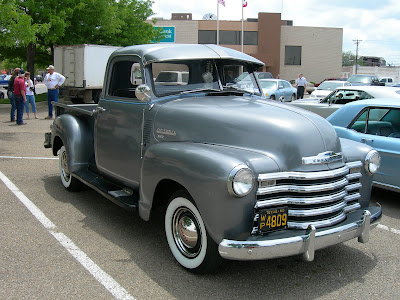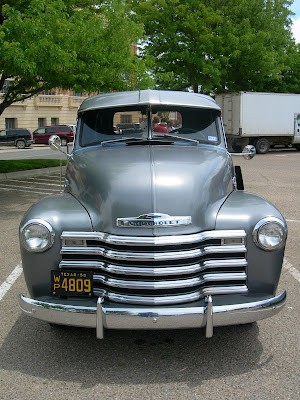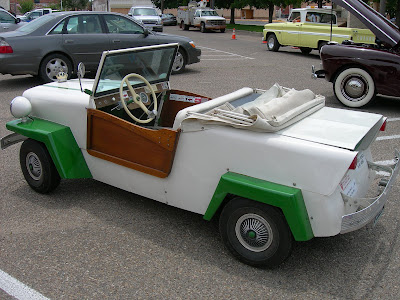Welcome to ToTG!
|
May 23, 2009
'50 Chevy Trucks
(click any pic for larger view)

From "How Stuff Works"
(Note: After seeing quite a few hits on this post, I thought I should clarify something: The photographs are mine, the info comes from "How Stuff Works)
1950 Chevrolet Truck
The 1950 model year brought about the end of the postwar seller's market. Now, suddenly, America's insatiable appetite for anything on wheels came to an abrupt halt. Buyers were starting to pick and choose again (though they would make 1950 a record-setting year for car and truck purchases, spurred on to some degree by the start of war in Korea). Trucks had sold well during the previous four years, and Chevrolet had topped the market; total Chevy truck registrations had reached 345,519 by '49. But with buyers now in control, Detroit recognized that the sales race was about to heat up.

Even so, not much changed on 1950 Chevrolet trucks. Horsepower and torque did increase by two on the Thrift-Master, to 92 horsepower at 3,400 rpm and 176 pound-feet at 1,000-2,000 rpm, thanks mainly to a revised Rochester carburetor and slightly bigger exhaust valves. Tubular rear shocks became standard, and the three-quarter-ton pickup now used eight-leaf front springs.

On panels and canopy expresses, a new single-sheet plywood load floor replaced multiple-board construction for better dust sealing. The Suburban resorted to single-tone standard paint and made available panel-style rear doors, marking the first time since 1946 that customers could choose between side-hinged doors or a top-and-bottom tailgate.
In 1949, Edward H. "Crankshaft" Kelley became Chevrolet's chief engineer. He continued to make minor improvements in the division's trucks, but he concentrated on his main areas of expertise, namely economy of manufacture and plant efficiency. Under Kelley's direction, Chevy's 1951 pickups lost some of their previous standard equipment, notably the rear bumper and spare-tire locks. But he did add conventional door-window ventipanes to replace the cowl vent on the driver's side.
3600 Model
I didn't research extensively, but I found a post in a forum that stated the only basic difference between the 3600 and the 3100 models was the bed size (8ft. bed and 6ft. bed respectively) and the heavier duty suspension, as well as the # of lug nuts(8 lugs and 6 lugs repectively)


Both trucks had lovely wooden slat beds.

May 22, 2009
buss
buss \BUS\ , noun, verb:
1. A kiss; a playful kiss; a smack.
transitive verb:
1. To kiss; especially to kiss with a smack.
Reminds me of the time riding home from a ball game when I tried to kiss the head cheerleader. That kiss ended with a smack, for sure.
Yep, my attempt at a buss on the bus was a bust.
King Midget
There was a car show at a downtown bank's parking lot and I noticed this little gem straightaway.

From a car club website:
The evolution of King Midget began in 1946 when Claud Dry and Dale Orcutt, who met while civil air patrol pilots during World War II, conceived King Midget as an inexpensive, affordable car that anyone could buy. They developed and sold King Midget as a single passenger kit car in which any single cylinder engine could be installed. The kit contained the frame, axles, springs, steering mechanism, dimensioned patterns for the sheet metal, which could be fabricated by a local metalsmith, and an assembly book. In the late 1940’s, and through 1951, the Model 1 became available from the factory as either a kit or as a fully assembled car with a 6 h.p. Wisconsin engine.
Glancing through the different types, I determined that this was a Model 2.
(NOTE: I've been informed in the comments section that it is a Model 3. Thanks to the two posters who set me straight...and their courtesy is much appreciated. I've been corrected several times before on other posts but in a rude manner...and a couple of times they were the wrong ones, not me. In this case I'll defer to the experts. - Mike)
Note the crown hood ornament.


By 1951, Dry and Orcutt had developed the second model King Midget, a two passenger convertible offered either fully assembled or as a kit, powered by the 7.5 horsepower Wisconsin AENL engine. This model firmly established King Midget's reputation and incredible ability to perform extraordinary feats. It could carry more than its own weight, it could pull exceptionally heavy loads, it had the agility of a mountain goat; all over arduous terrain with durability and economy for thousands of miles.
It began as the 500 pound car for $500. The Model 2 King Midget was a basic vehicle with a hand start cable on the left, outside behind the seat. It had a black three spoke steering wheel, brown plastic seat upholstery, no speedometer and no reverse.
However, it was this model which first offered the optional automatic transmission, reverse, electric starter, shatter proof safety-glass tinted windshield, top, steel winter doors with sliding Plexiglas windows, hot air heater, speedometer, turn signals, hand operated controls for handicapped persons and the golf model, complete with two golf bag racks, extra wide traction tires on the rear, special low gearing, foot rests on the front fenders and an extra quiet muffler system. The Custom model was introduced in 1955, along with the standard model King Midget. The Custom got a new two spoke white steering wheel, bright red and bone white upholstery, chrome bumper and cowl parking lights. New Philippine mahogany doors and winter enclosures became standard for both models, too.








